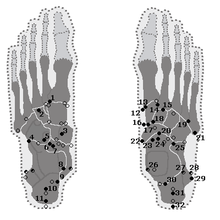- Carpus and tarsus of land vertebrates
-
The carpus (wrist) and tarsus (ankle) of land vertebrates primitively had three rows of carpal or tarsal bones. Often some of these have become lost or fused in evolution.
- Three proximals. In the hand humans has all three. In the foot the middle proximal appears in 5-15% of people as an os trigonum.[1]
- Centrale or os centrale, on the medial side. In humans and our closest relatives the African apes (chimpanzees and gorillas) it fuses to the scaphoid where it forms the articulation with the trapezoid bone; occasionally it stays separate. In Man's foot it is the navicular. Some early land vertebrates had more than one (up to three) os centrale per hand or foot (plural "(ossa) centralia").
- Distals, one per finger / toe at the base of each metacarpal or metatarsal. In mammals the 4th and 5th fuse. In the horse the 1st is lost.
See also
References
- ^ Cluett, Jonathan (August 2003). "Os Trigonum". About.com. http://orthopedics.about.com/cs/footanklesurgery/g/ostrigonum.htm. Retrieved December 2009.

This anatomy article is a stub. You can help Wikipedia by expanding it.


